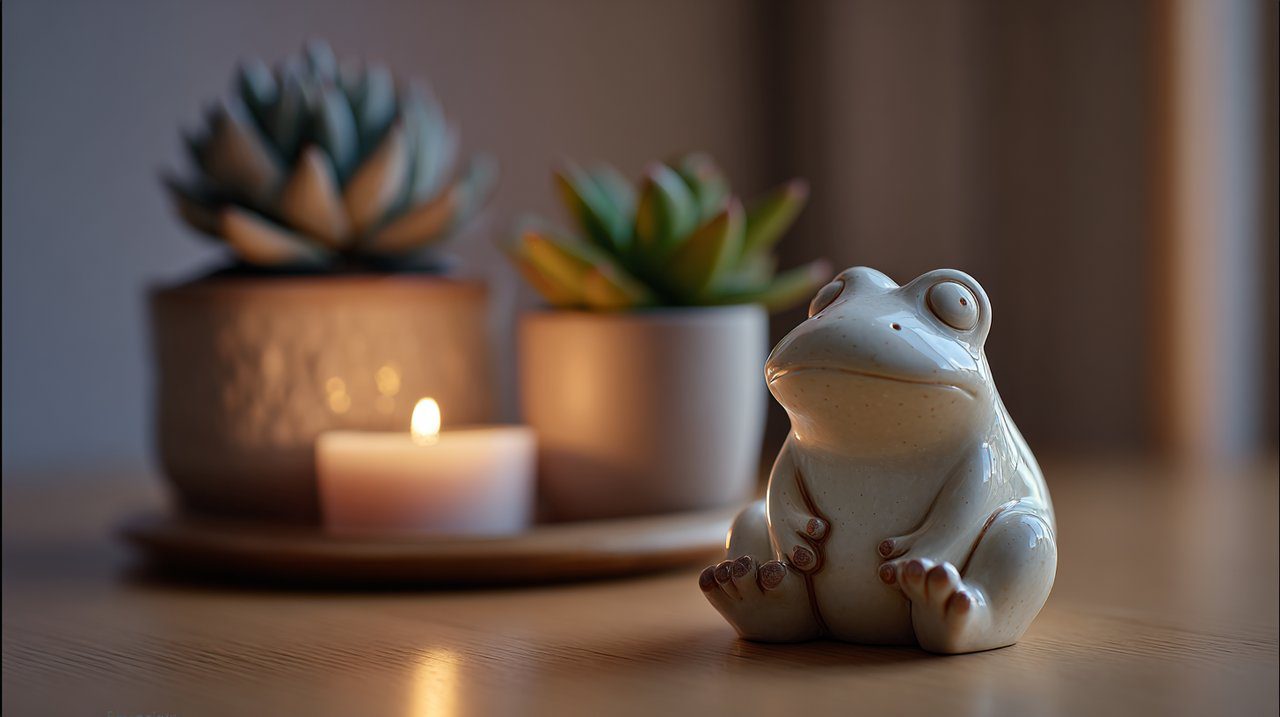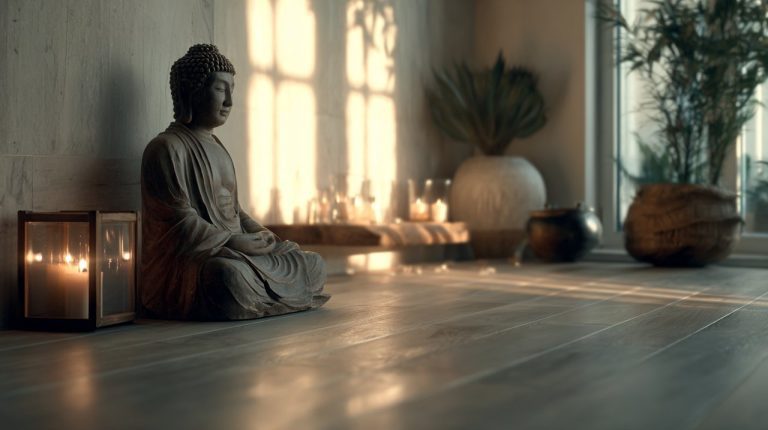The Zen Frog: A Silent Guide to Inner Harmony and Transformation
The Zen Frog: A Silent Guide to Inner Harmony and Transformation
The Zen Frog Statue, often poised in quiet contemplation, appears to embody stillness. Yet, this very immobility serves as a potent symbol for dynamic transformation and the cultivation of deep inner peace. How does an object, fixed in form, become a catalyst for such fluid, internal processes?
This apparent contradiction invites a closer examination, positioning the Zen Frog Statue not merely as an aesthetic piece, but as a significant artifact linking diverse spiritual philosophies to personal growth. It functions as a silent mentor, offering insights from ancient wisdom traditions that remain acutely relevant in our often-turbulent modern landscape.

The Paradox of Stillness: A Zen Frog’s Unifying Symbolism
Initially, a Zen Frog Statue might seem like a simple garden ornament or a decorative item. However, its subtle presence often conceals rich layers of meaning, drawn from ancient traditions and contemporary spiritual practices. To truly appreciate its significance, one must look beyond its physical form to understand its deeper implications.
Origins and the Silent Gaze
The origins of the Zen Frog Statue are not singular but stem from a confluence of Eastern philosophies, particularly Zen Buddhism and elements of Taoism. These traditions consistently view nature as a profound teacher, with its creatures often serving as potent metaphors for human experience and spiritual pathways. Just as the vibrant Koi fish symbolizes perseverance and strength in many Eastern narratives, the frog, with its meditative posture and silent watch, embodies a natural state of being.
The frog, with its meditative posture and silent watch, embodies a natural state of being. It is an observer, unhurried by external demands, reflecting a mindful presence. This inherent tranquility, captured in the statue’s form, invites the viewer to pause and reflect, mirroring the frog’s own quiet contemplation. It is a subtle invitation to stillness in a world of constant motion.
This deep symbolic resonance, rooted in centuries of spiritual thought, elevates the statue beyond mere decoration.
Beyond Decor: A Spiritual Anchor
Beyond its visual appeal, the Zen Frog Statue functions as a spiritual anchor. It is a tangible reminder of principles such as mindfulness, patience, and resilience. For many, its deliberate placement in a garden or indoor space represents an intentional act, designed to infuse the environment with a palpable sense of calm and spiritual intention. In a similar vein, objects like Tibetan prayer wheels serve as spiritual tools, aiding in the accumulation of merit and wisdom through their rotational action, creating a palpable sense of calm.
Whether positioned amidst the verdant textures of a garden or on a quiet desktop, its presence subtly shifts the energetic quality of the space, fostering a more introspective and peaceful atmosphere. It acts as a constant, gentle prompt for inner reflection.
Universal Symbolism: Decoding the Zen Frog’s Echoes of Enlightenment
The Zen Perspective: Mindfulness and Metamorphosis
In Zen Buddhism, the frog’s lifecycle—from tadpole to adult—is a powerful metaphor for metamorphosis and spiritual awakening. This journey of transformation, shedding old forms to embrace new ones, directly parallels the human spiritual path of growth and enlightenment. This perspective highlights several key attributes:
- Stillness: The frog’s ability to sit motionless for extended periods reflects the meditative state, emphasizing mindfulness and present-moment awareness.
- Transformation and Adaptability: Its biological evolution symbolizes personal and spiritual development, underscoring the continuous process of becoming. Living both in water and on land, the frog represents adaptability and balance, crucial qualities for navigating life’s inherent challenges.
This perspective sees the Zen Frog Statue as an embodiment of the potential for deep inner change, a silent testament to the journey within. The paradox of stillness facilitating dynamic transformation finds its echo in Taoist concepts of ‘wu wei’ (non-action), where effortless action arises from a state of inner quietude, enabling profound shifts without overt struggle.
Feng Shui’s Prosperity: Auspiciousness and Abundance
While Zen primarily emphasizes internal transformation, Feng Shui, a Chinese philosophical system focused on harmonizing individuals with their surrounding environment, attributes different but equally significant meanings to the frog, particularly the three-legged money frog (Chan Chu). Similar to how symbols like the powerful Pixiu or the animals of the Sheng Xiao are revered for their auspicious energies, the frog in Feng Shui is a potent emblem. This divergence offers a compelling comparison:
- Wealth and Prosperity: In Feng Shui, the frog is a potent symbol of wealth, prosperity, and abundance. Often depicted with a coin in its mouth, it is believed to attract good fortune and financial gain. The red color symbolism frequently associated with these objects further amplifies their auspicious energy, signifying luck and protection.
- Protection: It also serves as a guardian against negative energy, ensuring the harmonious flow of positive chi within a space.
Comparing these two interpretations reveals a fascinating duality: Zen focuses on the internal wealth of peace and transformation, while Feng Shui emphasizes external prosperity. Yet, both ultimately aim for a state of harmony—one through inner balance, the other through environmental alignment—demonstrating the frog’s versatile symbolic power.
Cross-Cultural Interpretations: The Frog’s Diverse Symbolism
Beyond Zen and Feng Shui, frogs hold significant symbolic weight in various cultures, showcasing their universal appeal as a creature of deep meaning. Much like elephants in mythology often symbolize wisdom, strength, and good fortune across diverse traditions, frogs too carry rich cultural narratives:
- Rebirth and Fertility: In ancient Egypt and some Native American traditions, frogs symbolize rebirth, fertility, and cleansing, largely due to their intrinsic connection with water and their regenerative abilities.
- Good Luck: In many European folklores, frogs are considered bringers of good luck and omens of rain, which is vital for agricultural prosperity.
These diverse interpretations underscore the frog’s universal association with positive change, growth, and the cyclical nature of life, making it a truly cross-cultural emblem of hope and renewal.
Integrating the Zen Frog: Cultivating Inner Harmony
Integrating a Zen Frog Statue into one’s personal environment is a conscious act, requiring thoughtful consideration of placement, material, and ethical sourcing. This process transforms a simple object into a meaningful companion for one’s spiritual journey.
Sanctuary for the Senses: Placement in Meditation and Garden
- Meditation Space: Placing a Zen Frog Statue in a meditation corner or on an altar can serve as a visual anchor, aiding in focus and gently reminding one of the principles of stillness and transformation.
- Garden Decor: For a zen frog statue for garden decor, positioning it near a water feature or amidst natural foliage enhances its connection to nature and promotes a tranquil outdoor sanctuary.
- Work/Study Area: A small statue on a desk can provide a subtle, calming presence, encouraging focused work and mindful breaks, serving as a visual cue to pause and recenter.
Regardless of location, the key lies in choosing a spot where its presence can be fully appreciated and where it genuinely contributes to the desired atmosphere of calm and introspection.

Selecting a Companion: Material and Craftsmanship
Selecting a Zen Frog Statue is a deeply personal process. Beyond mere aesthetics, one should consider the material and craftsmanship, as these elements contribute significantly to its energetic quality and longevity. Different materials can subtly influence the perceived energy and symbolic weight of the statue, for instance, a stone frog might evoke greater stability, much like the enduring qualities associated with jade stone meaning chinese culture. Common materials include:
- Resin/Fiberglass: Lightweight, durable, and weather-resistant, making them ideal for outdoor use.
- Stone/Concrete: Heavy, stable, and naturally grounding, offering a rustic, enduring appeal that speaks to permanence.
- Bronze/Metal: Often more intricately detailed, conveying a sense of permanence and timeless elegance.
- Ceramic/Porcelain: Delicate, often featuring detailed glazes, making them particularly suitable for indoor display where their artistry can be admired.
Furthermore, consider the scale relative to your intended space and the specific posture of the frog. A larger, more prominent statue might serve as a garden centerpiece, while a smaller, contemplative one suits a meditation altar. Some statues also include additional symbolic elements like lotus flowers, coins, or specific mudras, each adding layers of meaning. When reflecting on how to choose a zen frog statue, consider which elements resonate most with your personal aspirations and the sanctuary you wish to create.
Ethical Contemplations: Sourcing and Sustainability
Supporting artisans who use sustainable practices and fair labor can deepen the positive energy associated with your purchase, aligning the object’s origin with its intended purpose of harmony. This conscious choice extends the principles of mindfulness beyond personal space to global responsibility, creating a more holistic sense of well-being.
The Zen Frog: A Catalyst for Transformation Beyond Form
The Journey Within: A Daily Reminder
The consistent presence of a Zen Frog Statue serves as a constant, gentle reminder to cultivate inner peace amidst life’s inevitable flux. It subtly encourages us to:
- Pause and Breathe: To intentionally carve out moments for mindful reflection throughout the day, detaching from constant external demands.
- Observe Change: To view life’s transitions and challenges as opportunities for deep growth, much like the frog’s remarkable metamorphosis.
- Seek Stillness: To discover and access the calm center within ourselves, regardless of the turbulent external circumstances that may arise.
It acts as a silent teacher, guiding us back to our own inherent resources of tranquility and resilience, demonstrating that true strength often lies in quiet observation and adaptability. These principles of inner strength and adaptability are crucial for navigating life’s complexities. Symbols of Strength & Resilience: Decoding Ancient Wisdom for Enduring Spirit
Curating Your Sacred Space: A Path to Deeper Harmony
The Zen Frog Statue embodies a compelling paradox: its stillness is a testament to dynamic transformation. It acts as a powerful bridge, unifying the introspective journey of Zen with the environmental harmony of Feng Shui, ultimately pointing towards a universal human pursuit of balance and well-being.
By consciously integrating this symbol into your environment, you are not merely decorating a space; you are actively curating a sanctuary that reflects and fosters your deepest aspirations for peace, growth, and a more mindful existence. This silent guide, in its quiet contemplation, invites us all to embark on a similar journey within, discovering profound stillness as the wellspring of dynamic change.
💡 Frequently Asked Questions
A Zen Frog Statue serves as a profound symbol for dynamic transformation, the cultivation of deep inner peace, and a reminder to find stillness amidst life's flux.
In Zen Buddhism, the frog's lifecycle represents metamorphosis and spiritual awakening. It embodies stillness for mindfulness, transformation for personal growth, and adaptability for navigating challenges.
In Feng Shui, the frog (especially the three-legged money frog) is a potent symbol of wealth, prosperity, abundance, and protection, aiming to attract good fortune and ensure the harmonious flow of positive energy.
Zen Frog Statues are commonly placed in meditation corners, gardens (especially near water features), or on quiet desktops. The key is to choose a spot where its presence can contribute to a calm and introspective atmosphere.







